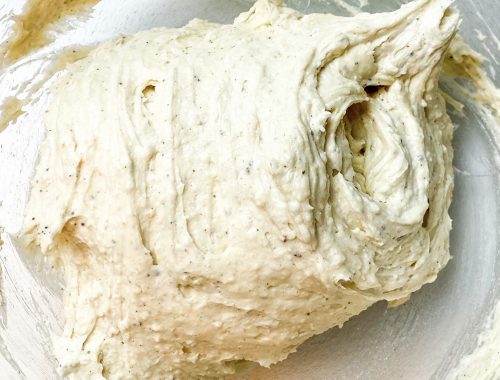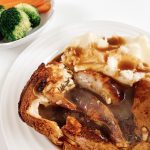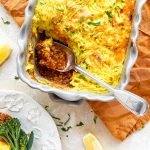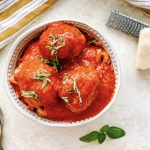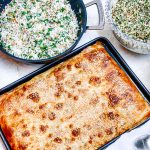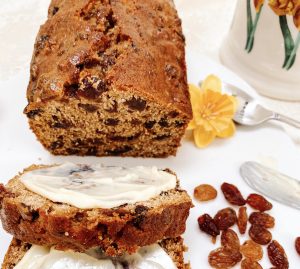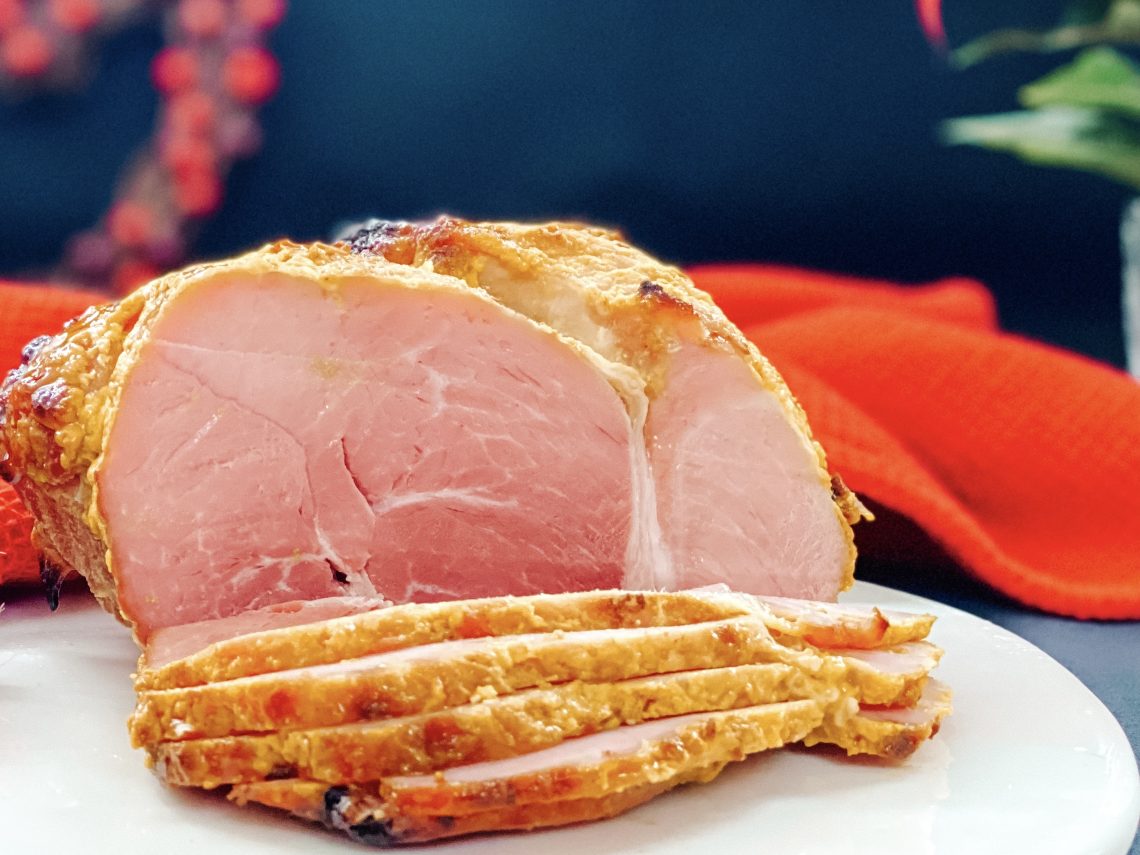
Baked Ham with Demerara Sugar and English Mustard
Although I make this all year round it is an absolute staple for us over the Christmas period. On Christmas Eve, we eat either Andrew’s favourite Fish Pie or we will have this Baked Ham with mashed potatoes and parsley sauce. We then have the remainder of the ham over the Christmas period in croquettes or ham cakes, quiche lorraine and, of course, plenty of ham and mustard sandwiches.
The ham is beautifully moist with a sweet yet hot mustard topping which infuses into the meat. Like my Christmas pudding recipe, this is one I have been making for donkey’s years and is from Delia Smith’s Christmas Cookery Book, published way back when.
Christmas just wouldn’t be the same without it, and as we often have many guests, I usually cook a large gammon joint. However, I appreciate that this year, many of us are having different and smaller celebrations, so I decided to try the recipe out on a small joint. I’m pleased to say, it was just as delicious!
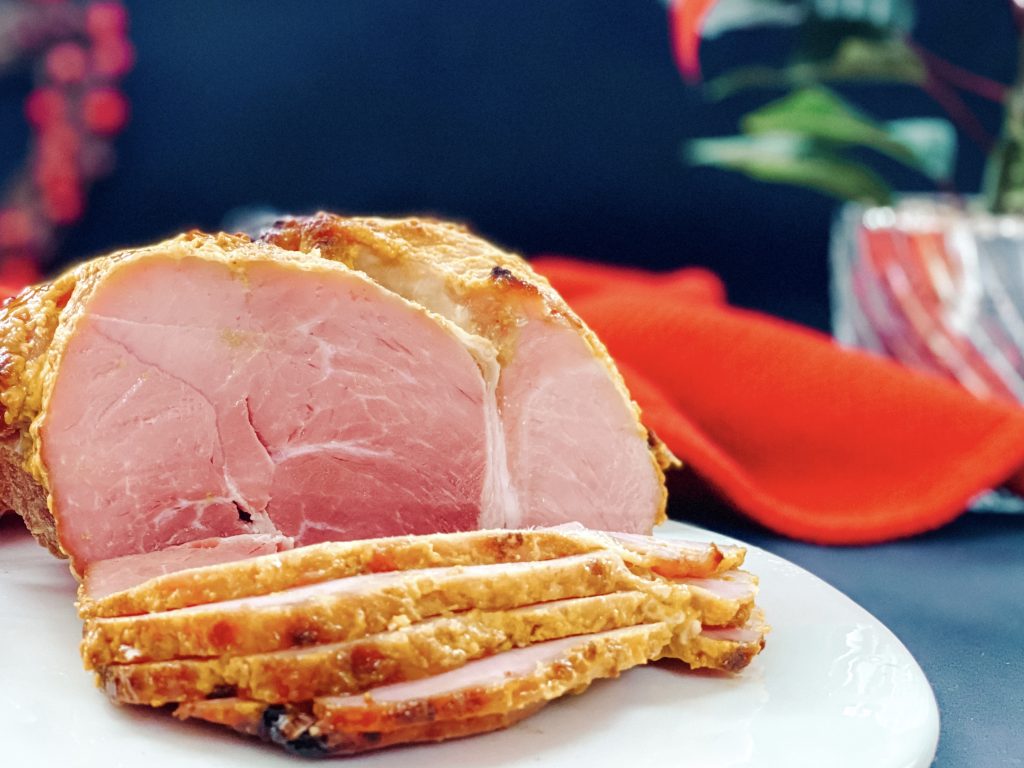
How to make Baked Ham with Demerara Sugar and English Mustard
When I was a child, I remember my mother and grandmother always pre-soaking gammon joints before cooking them to remove the strong salty flavour. These days it is rarely necessary, but it is best to check with your butcher just in case. Or, if you bought your ham from a supermarket, there will be instructions on the packet. Always check.
What is the difference between gammon and ham?
Basically gammon is uncooked ham. This dish requires a gammon joint but once you have cooked it, it will be called ham!
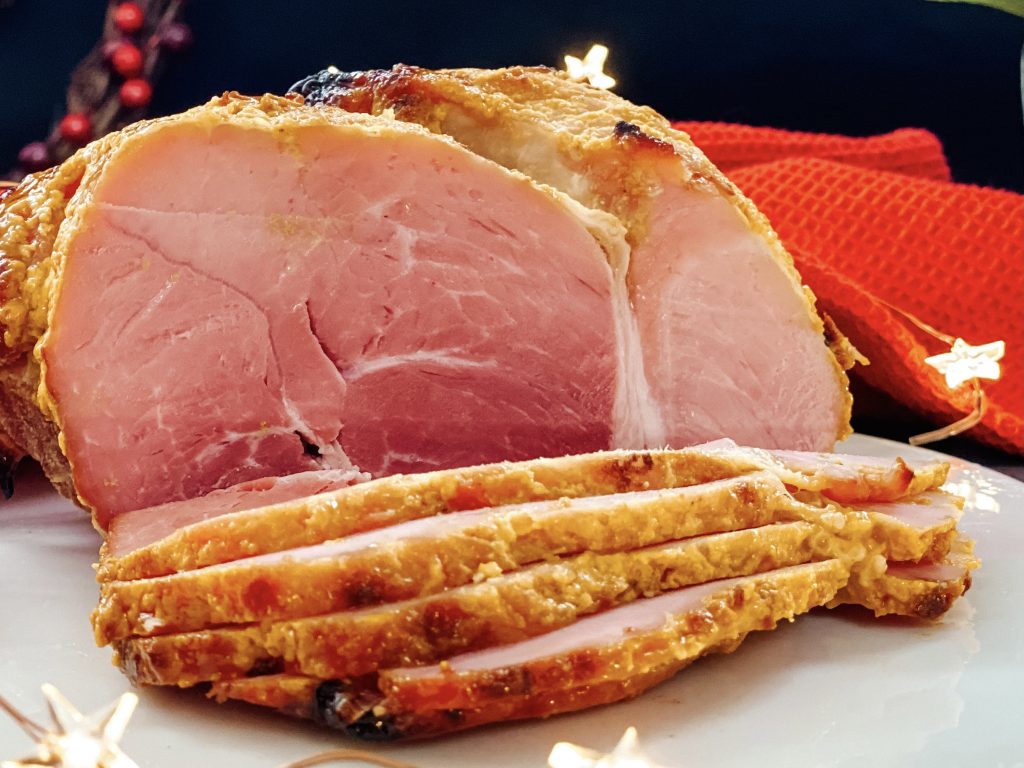
Collect the ingredients together:
- joint of gammon – either bone in or bone out
- Vegetable oil
- English mustard
- Demerara sugar
How to prepare and cook the gammon:
- Lay two pieces of foil vertically and horizontally over your baking tray They should be big enough to cover the gammon very loosely. Drizzle over a little oil.
- Use a brush or kitchen paper to spread this evenly over the foil.
- Sit the gammon in the centre of the foil.
- Bring up one piece of foil around the gammon and join at the top edge.
- Now bring up the second piece of foil and seal. You are creating a kind of tent. Seal the edges to prevent steam escaping and to ensure your joint stays moist.
- Turn round if necessary to fit the tray.
- Place in the centre of a pre-heated oven and set the timer for 30 minutes before the end of the cooking time. (To calculate your cooking times – see below.)
- 30 minutes before the end of cooking, take the joint out of the oven and unwrap the foil – be very careful as steam will escape and it will be very hot. Immediately increase the oven temperature.
- You now need to very carefully remove the rind – I wear gloves to do this because it will be very hot.
- You are supposed to leave a thin layer of fat, however I remove pretty much all of it. We just don’t like it in this house and I always believe that the best way to cook food, is for the way you like to eat it!
- Discard the fat and rind and cover the exposed surface with a thin layer of English mustard.
- Scatter over the demerara sugar and press down lightly with your hands to ensure it adheres to the mustard.
- Return to the hotter oven for 30 minutes until the sugar caramelises. Please note that some sugar will inevitably fall off the joint as you add it. You may smell it burning on the foil as it will cook more quickly than the sugar on the meat. Don’t worry about this but do keep an eye to ensure the sugar on the joint doesn’t burn. If, after 30 minutes, it has not caramelised to you liking, you can either crank the oven up to its hottest heat and cook for a few more minutes or pop under a heated grill until sufficiently caramelised. Keep a close eye though as it can burn easily.
- Remove from the oven when cooked to your liking.
- Your ham is now cooked. I like to eat mine at room temperature rather than hot, but if you prefer it warm or hot, it is best left for 30 – 45 minutes before slicing and serving to allow the juices to settle and the delicious glaze to be absorbed.
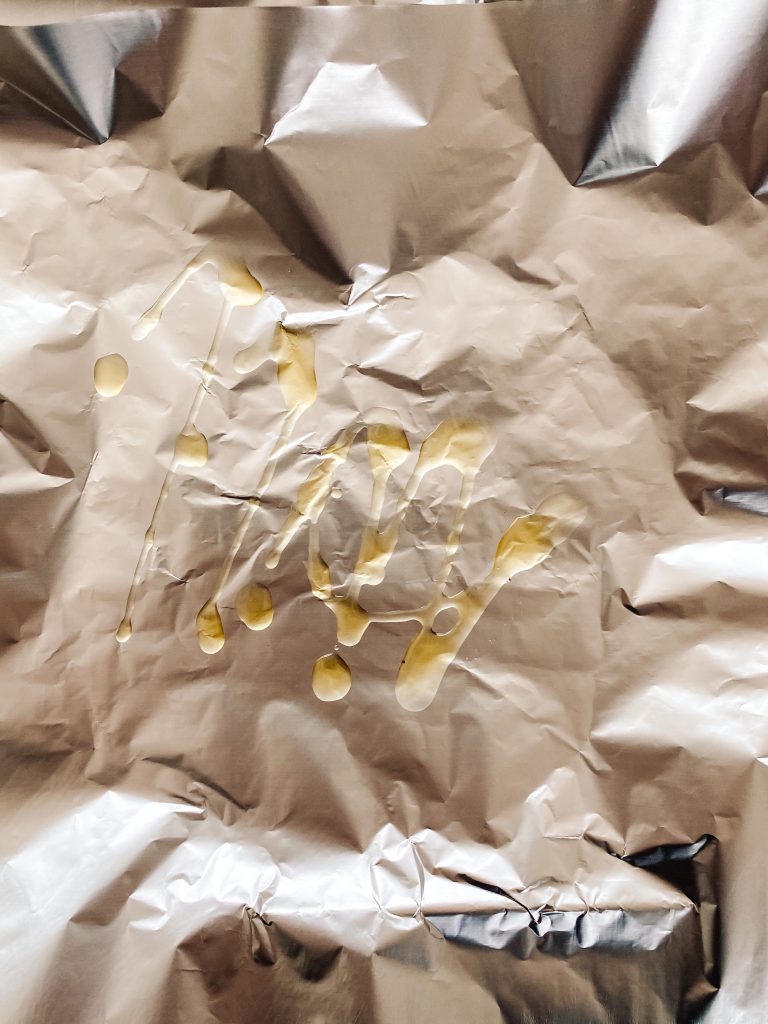
1 Drizzle oil on the foil 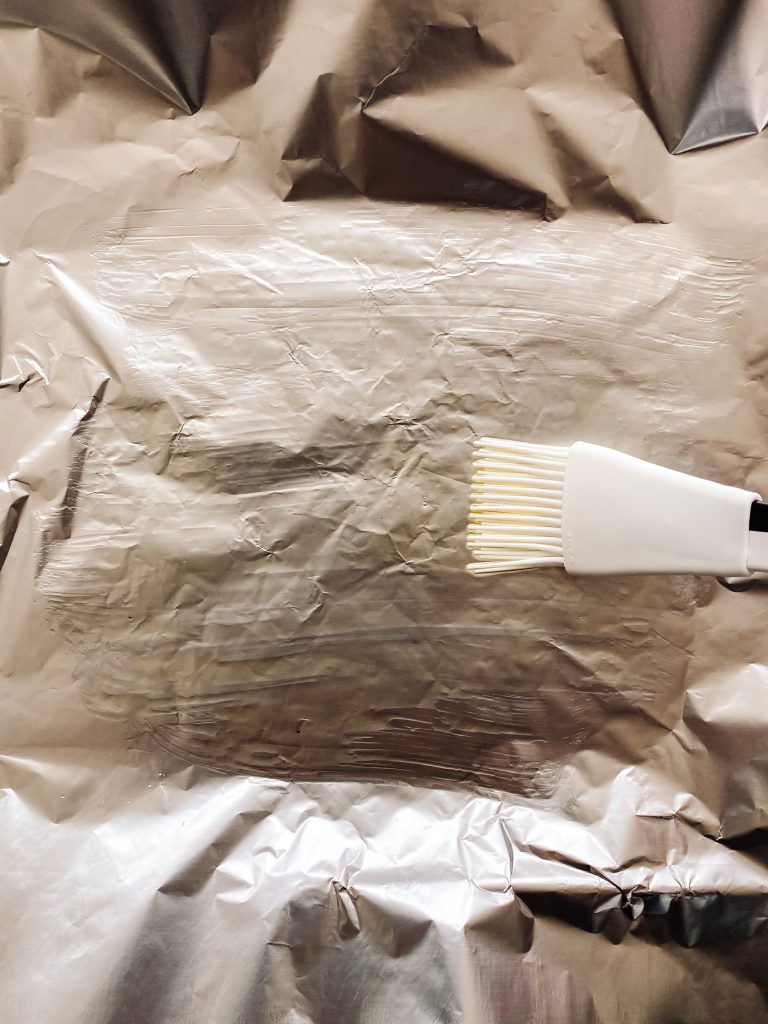
2 Spread the oil evenly over the foil. 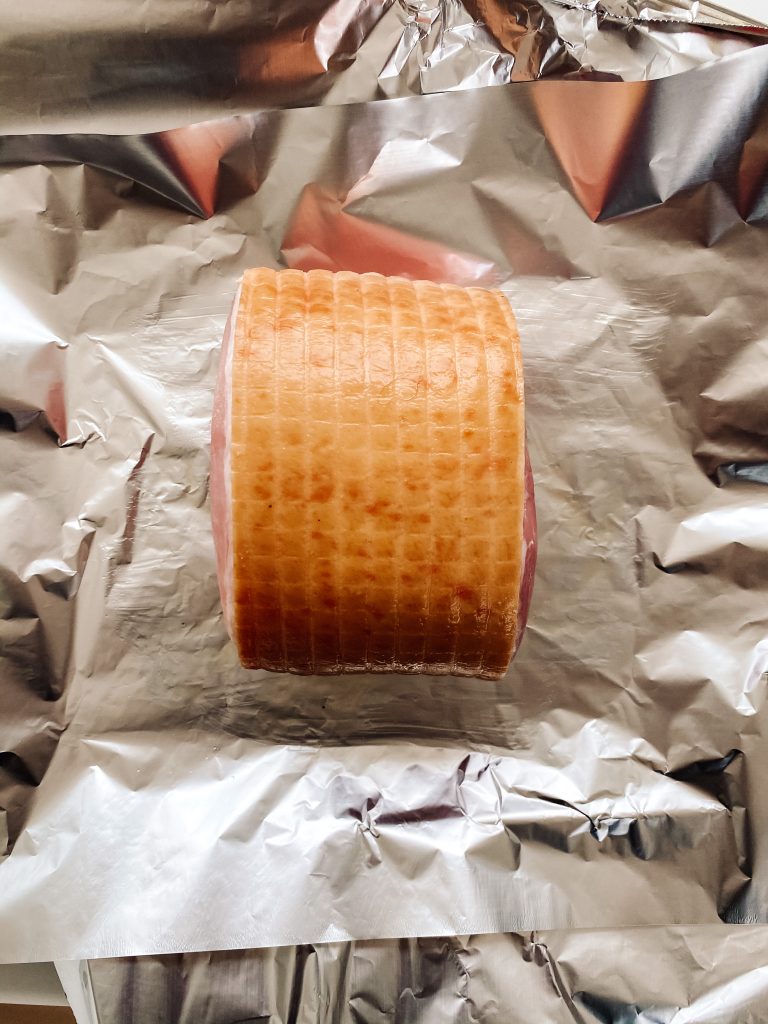
3 Sit gammon in centre of foil 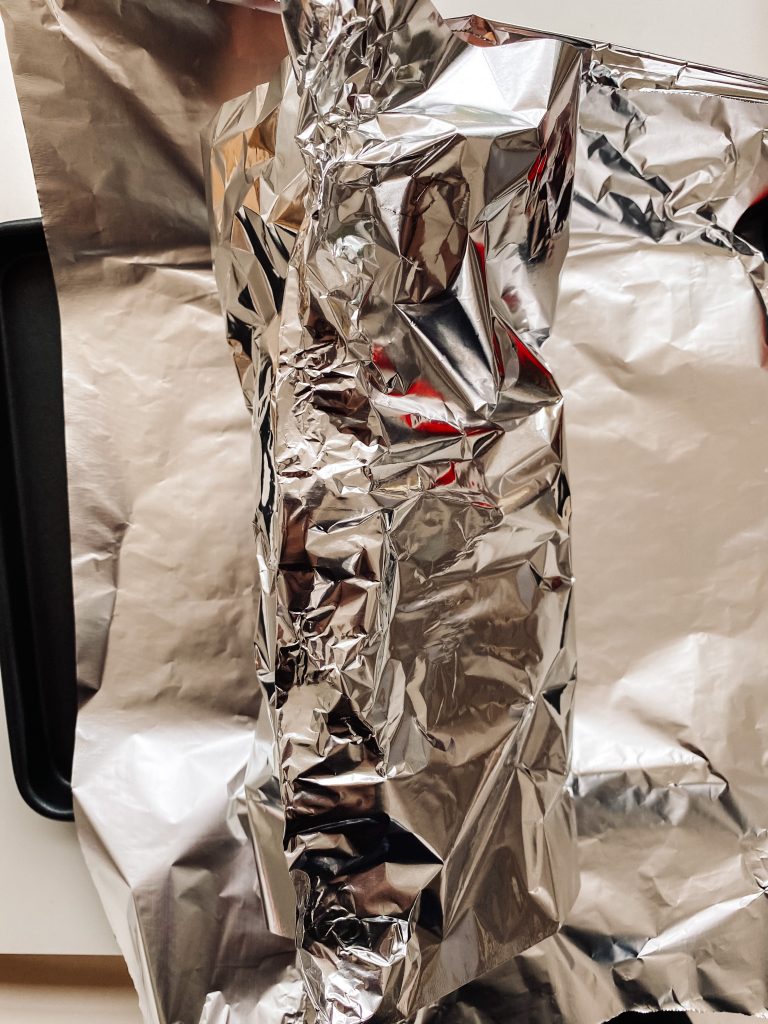
4 Bring up one piece of foil 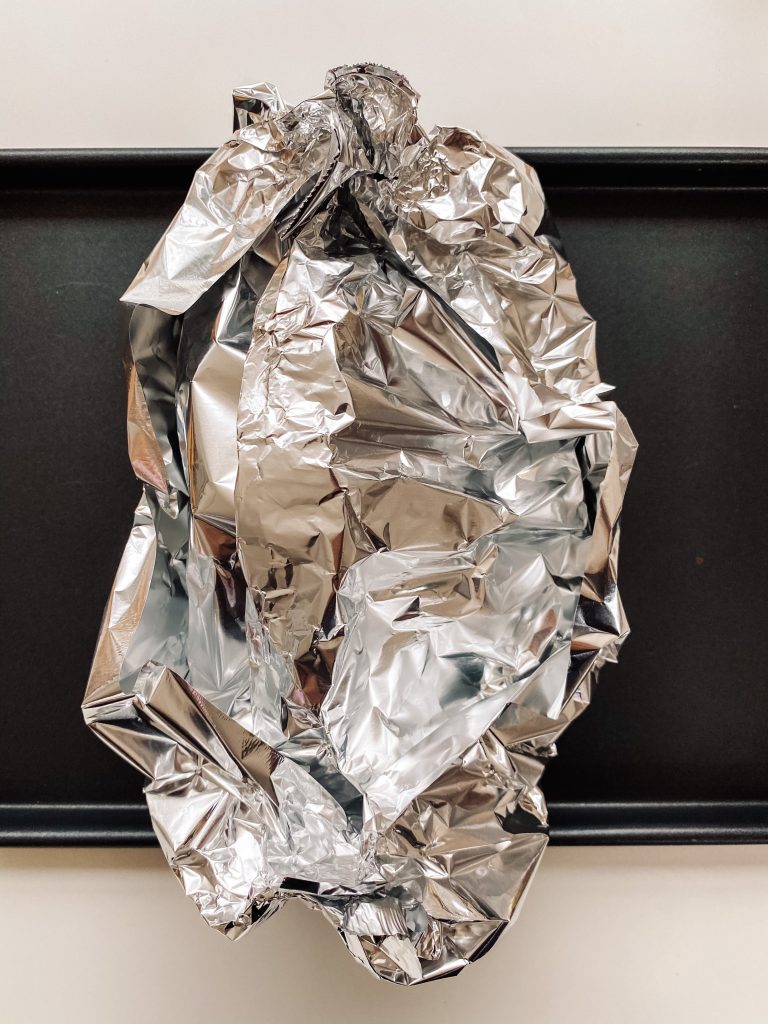
5 Bring up the second piece of foil and seal. 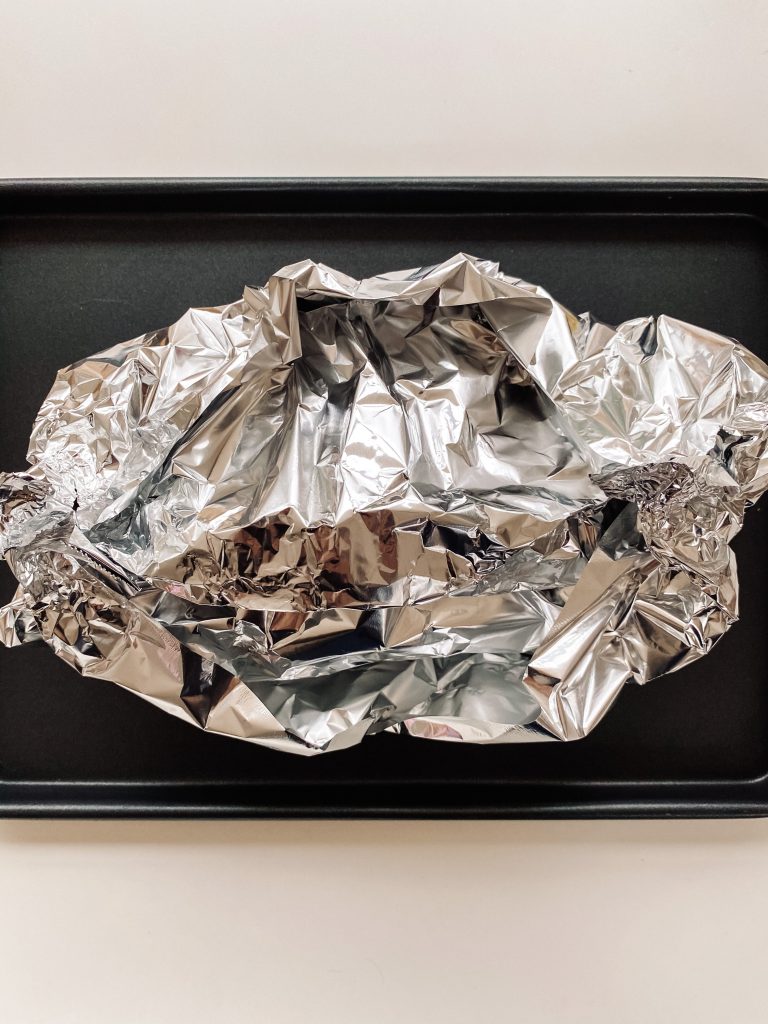
6 Turn round if necessary to fit the tray and cook 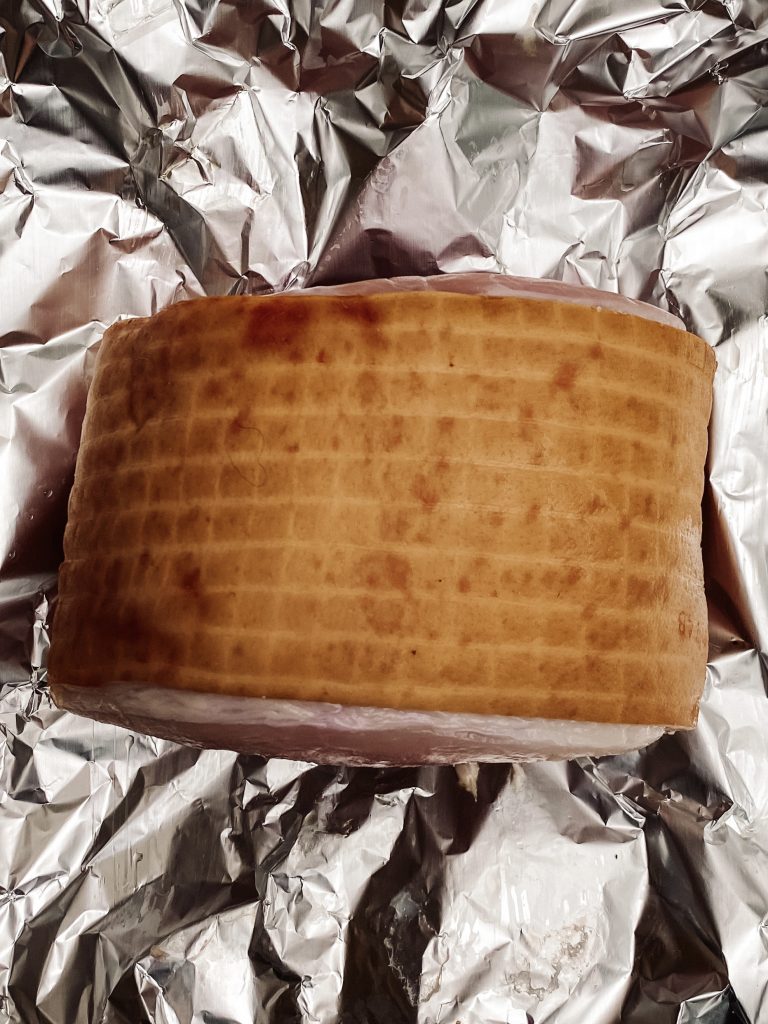
7&8 Remove from oven 30 mins before end of cooking time; open foil 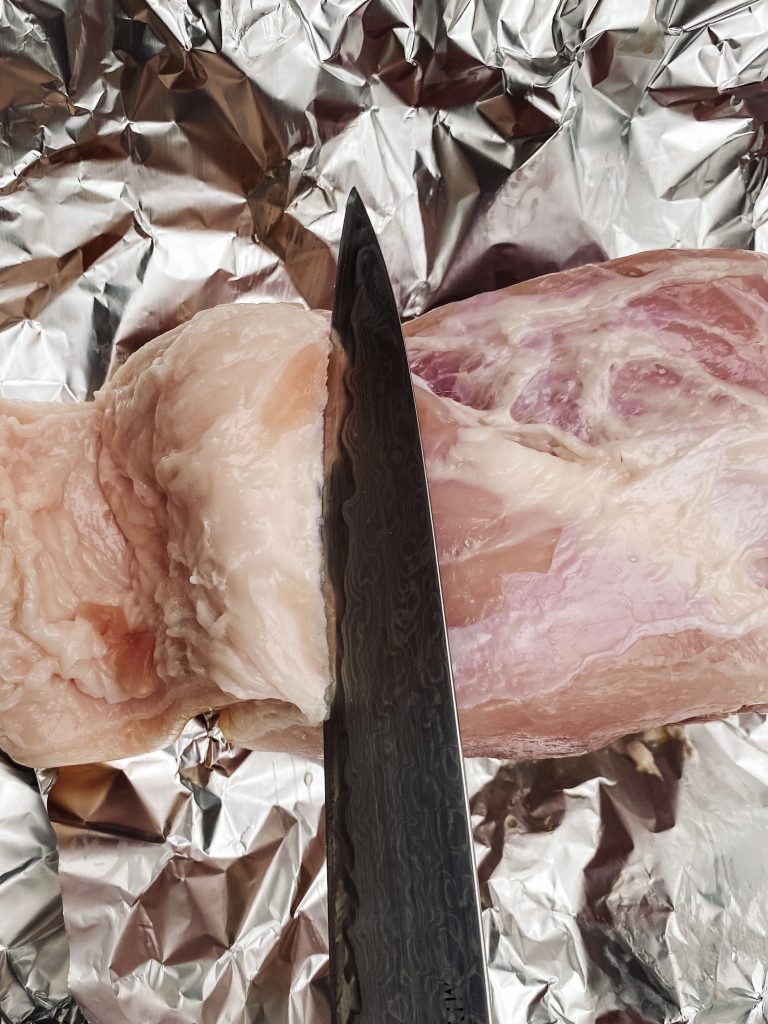
9 Increase oven temp and remove rind 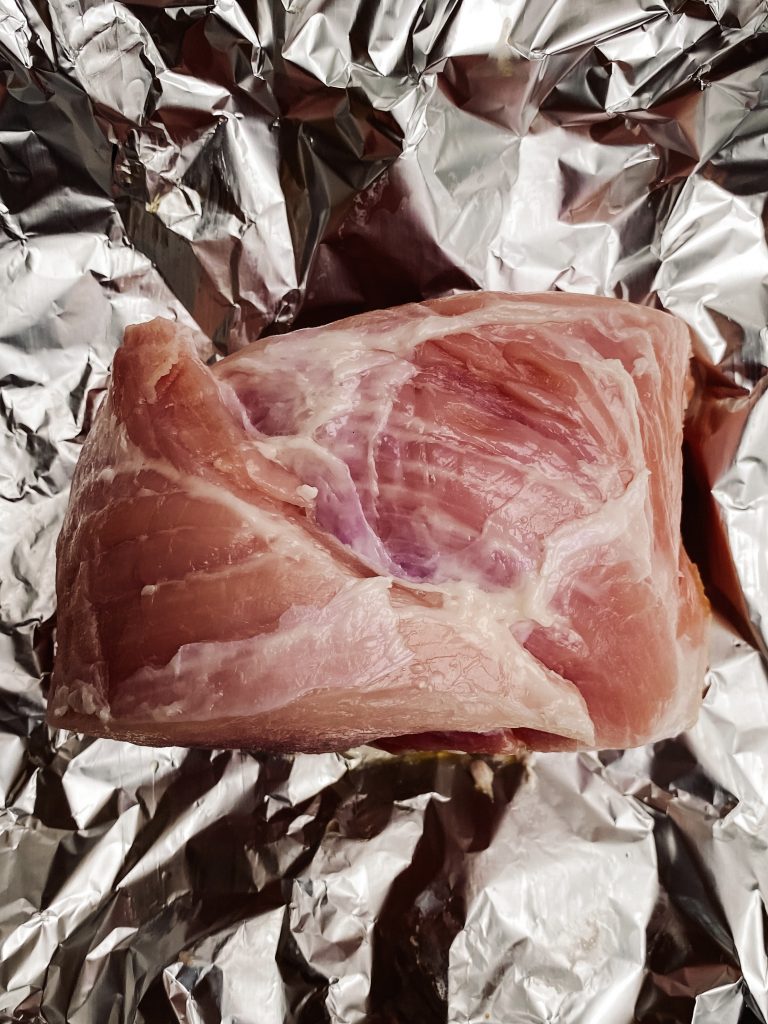
10 Either remove or leave a thin layer of fat 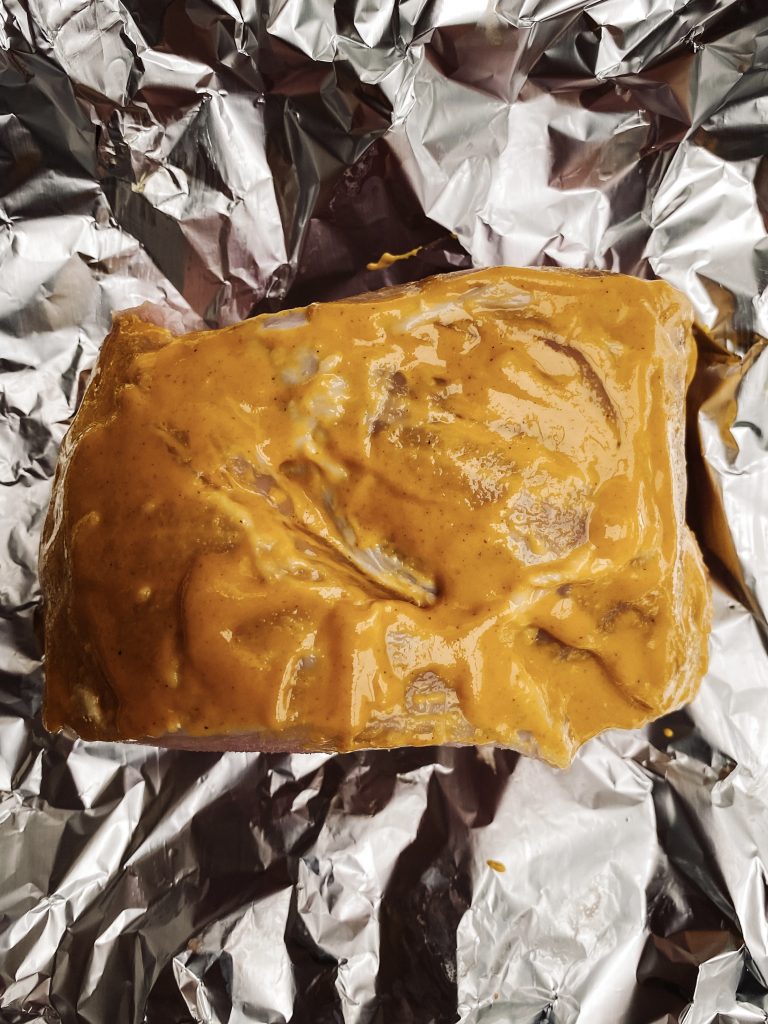
11 Cover exposed surface with English mustard 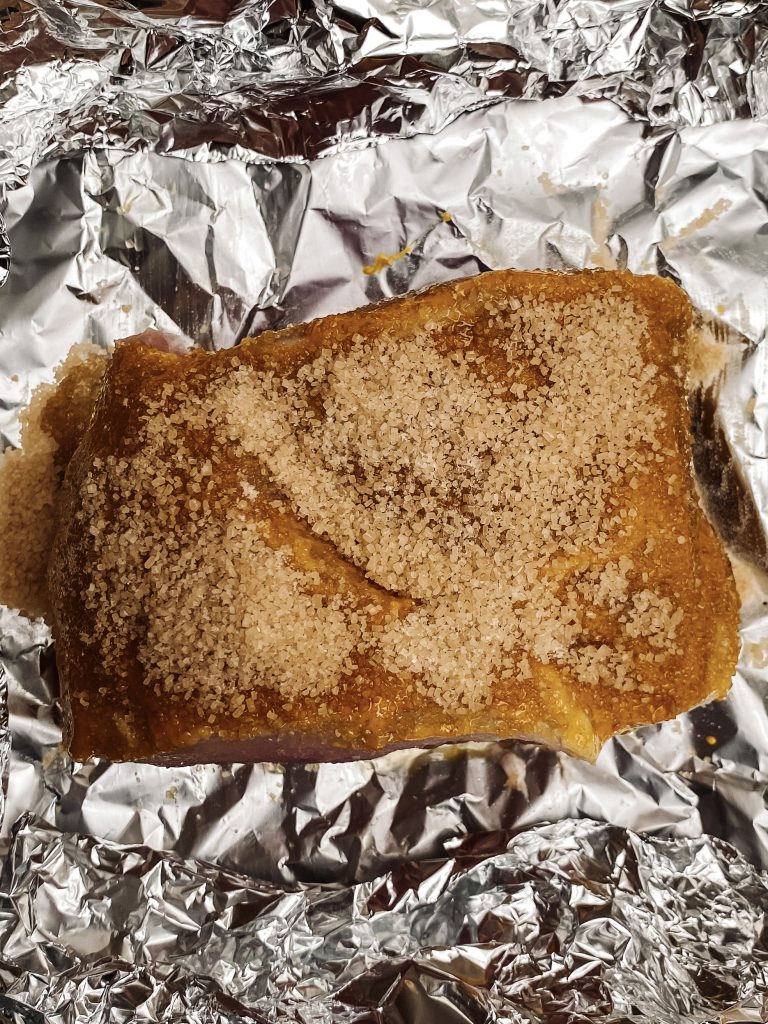
12 Scatter over the demerara sugar 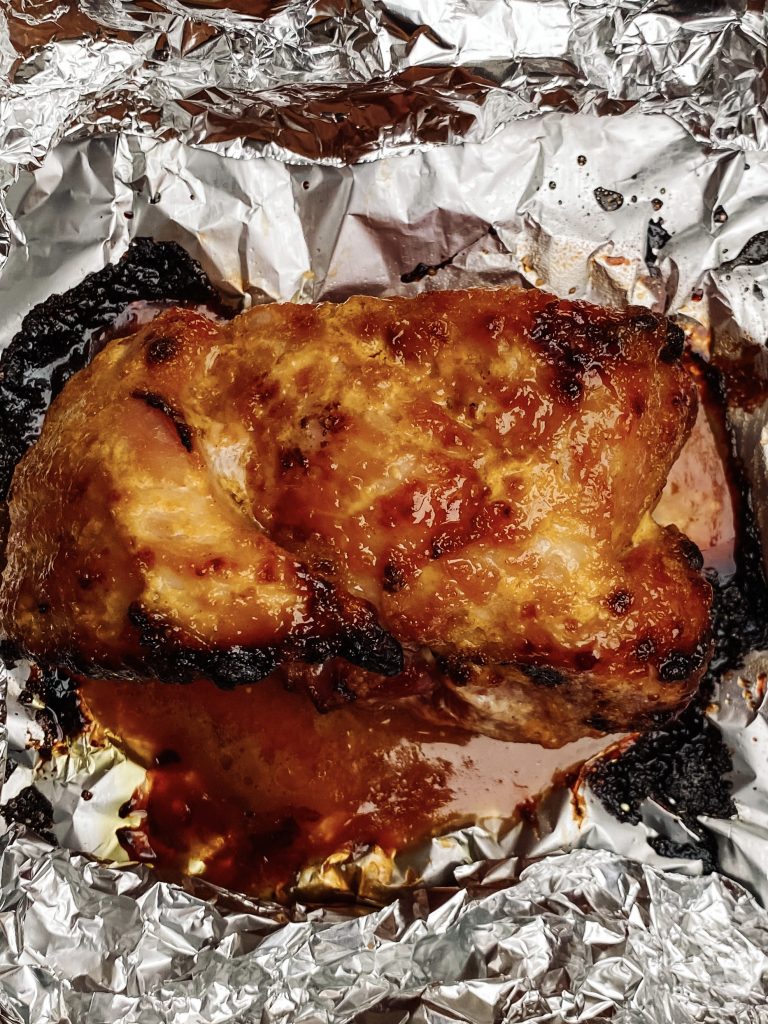
13 Return to hotter oven for 30 minutes 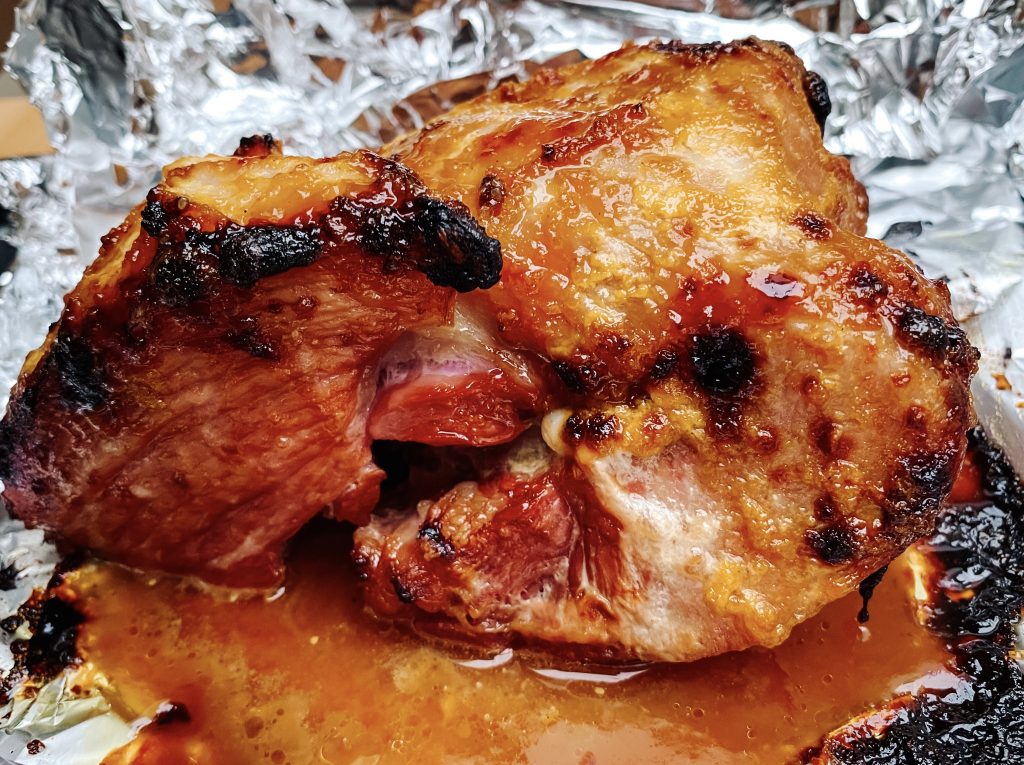
14 Remove from oven when cooked to your liking
How long do you cook a gammon joint?
This will depend on whether your joint has a bone in it or not.
Cooking times for a joint with a bone:
- Preheat oven to Fan Oven 140°C/160°C/325°F/Gas 3.
- 20 minutes per 450g/1lb
- For a 5.5kg/12lb ham that would be 4 hours and for a 6.5kg/14lb ham, 4 hours and 40 minutes.
- Calculate when last 30 minutes of cooking time will be for glazing. Take ham out and turn oven up to Fan Oven 200°C/220°C/425°F/Gas 7.
Cooking times for a joint without a bone:
- Preheat oven to Fan Oven 140°C/160°C/325°F/Gas 3.
- 30 minutes per 450g/1lb
- For a 2.25kg/5lb ham that would be 2½ hours and for a 2.75kg/6lb ham that would be 3 hours
- Calculate when last 30 minutes of cooking time will be for glazing. Take ham out and turn oven up to Fan Oven 200°C/220°C/425°F/Gas 7.
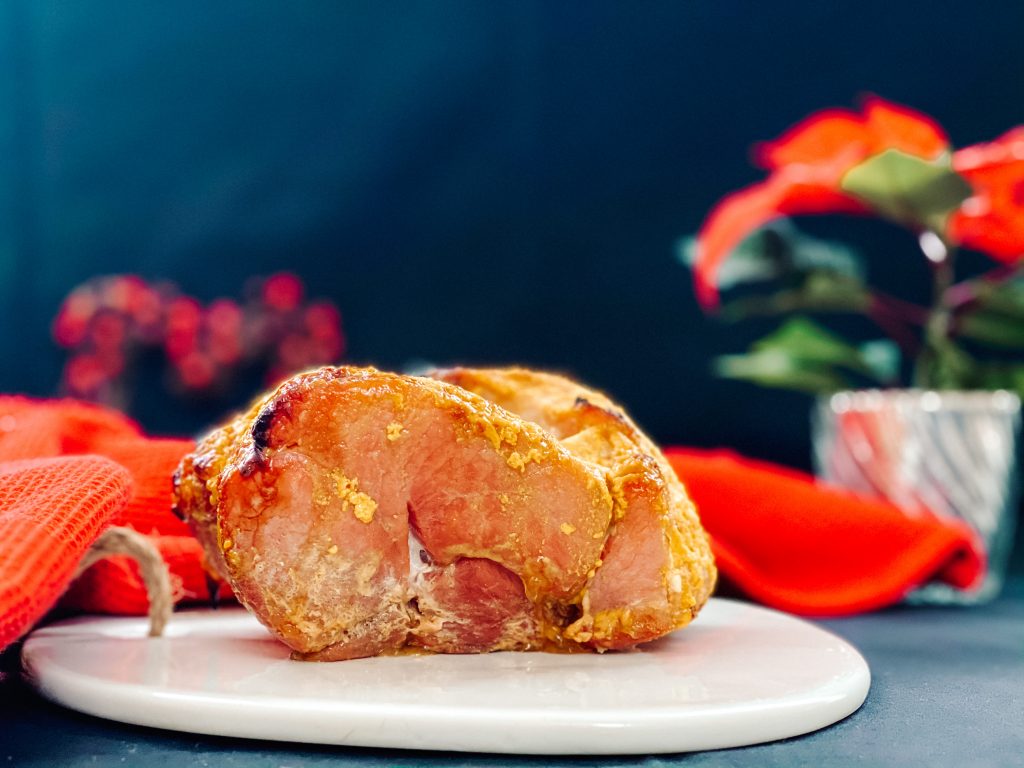
Made this recipe?
If you make this recipe, do please tag me on instagram @daffodil_kitchen. You could also leave a comment in the box directly below the recipe.
Baked Ham with Demerara Sugar and English Mustard
Ingredients
- gammon joint
- 1- 4 tablespoons English mustard
- 2- 6 tablespoons demerara sugar
Instructions
-
Collect together your equipment (see Recipe Notes below) and ingredients.
-
Preheat oven to Fan Oven 140°C/160°C/325°F/Gas 3.
-
Calculate the cooking time – see Recipe Notes below.
-
Lay two pieces of foil vertically and horizontally over your baking tray They should be big enough to cover the gammon very loosely. Drizzle over a little oil and use a brush or kitchen paper to spread this evenly over the foil.
-
Sit the gammon in the centre of the foil. Bring up one piece of foil around the gammon and join at the top edge. Now bring up the second piece of foil and seal. You are creating a kind of tent over the ham. Seal the edges to prevent steam escaping and to ensure your joint stays moist.
-
Place in the centre of a pre-heated oven and set the timer for 30 minutes before the end of the cooking time.
-
30 minutes before the end of cooking, take the joint out of the oven and unwrap the foil – be very careful as steam will escape and it will be very hot.
-
Immediately increase the oven temperature to Fan Oven 200°C/220°C/425°F/Gas 7.
-
You now need to very carefully remove the rind and most of the fat – I wear gloves to do this because it will be very hot.
-
You are supposed to leave a thin layer of fat, however I remove pretty much all of it as that is how we like it – your choice.
-
Cover the exposed surface with a thin layer of English mustard.
-
Scatter over the demerara sugar and press down lightly with your hands to ensure it adheres to the mustard.
-
Return to the hotter oven for 30 minutes until the sugar caramelises.
NB Some sugar will inevitably fall off the joint as you add it. You may smell it burning on the foil as it will cook more quickly than the sugar on the meat. Don’t worry about this but do keep an eye to ensure the sugar on the joint doesn’t burn. If, after 30 minutes, it has not caramelised to you liking, you can either crank the oven up to its hottest heat and cook for a few more minutes or pop under a heated grill until sufficiently caramelised. Keep a close eye though as it can burn easily. It should look golden and glazed.
-
Remove from the oven when cooked to your liking.
-
Your ham is now cooked. I like to eat mine at room temperature rather than hot, but if you prefer it warm or hot, it is best left for 30 – 45 minutes before slicing and serving to allow the juices to settle and the delicious glaze to be absorbed.
Recipe Notes
Equipment:
- baking tray and foil
- measuring spoons and sharp knife
Quantities:
The amount of mustard and sugar you need will depend on the size of the joint. For this small joint, which weighed just under 1kg, I used 1 tablespoon mustard and 2 tablespoons demerara sugar – although some of this did not stick on the joint!
How long do you cook a gammon joint for?
This will depend on whether your joint has a bone in it or not.
Cooking times for a joint with a bone:
- Preheat oven to Fan Oven 140°C/160°C/325°F/Gas 3.
- 20 minutes per 450g/1lb
- For a 5.5kg/12lb ham that would be 4 hours and for a 6.5kg/14lb ham, 4 hours and 40 minutes.
- Calculate when last 30 minutes of cooking time will be for glazing. Take ham out and turn oven up to Fan Oven 200°C/220°C/425°F/Gas 7.
Cooking times for a joint without a bone:
- Preheat oven to Fan Oven 140°C/160°C/325°F/Gas 3.
- 30 minutes per 450g/1lb
- For a 2.25kg/5lb ham that would be 2½ hours and for a 2.75kg/6lb ham that would be 3 hours
- Calculate when last 30 minutes of cooking time will be for glazing. Take ham out and turn oven up to Fan Oven 200°C/220°C/425°F/Gas 7.
You May Also Like
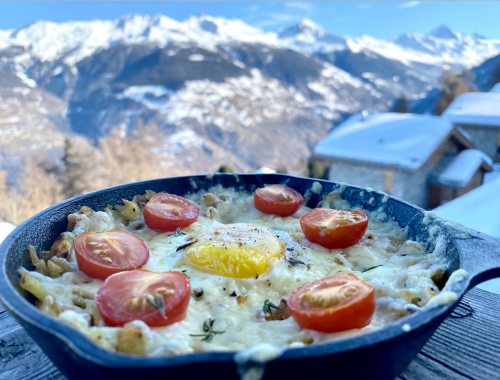
Swiss Rösti
20th January 2020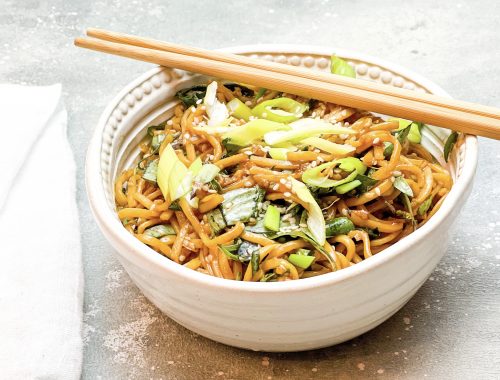
Sesame Ginger Noodles with Chilli, Garlic and Coriander
12th December 2021